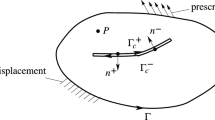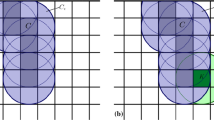Abstract
In the finite element method, the numerical simulation of three-dimensional crack propagation is relatively rare, and it is often realized by commercial programs. In addition to the geometric complexity, the determination of the cracking direction constitutes a great challenge. In most cases, the local stress state provides the fundamental criterion to judge the presence of cracks and the direction of crack propagation. However, in the case of three-dimensional analysis, the coordination relationship between grid elements due to occurrence of cracks becomes a difficult problem for this method. In this paper, based on the extended finite element method, the stress-related function field is introduced into the calculation domain, and then the boundary value problem of the function is solved. Subsequently, the envelope surface of all propagation directions can be obtained at one time. At last, the possible surface can be selected as the direction of crack development. Based on the aforementioned procedure, such method greatly reduces the programming complexity of tracking the crack propagation. As a suitable method for simulating tension-induced failure, it can simulate multiple cracks simultaneously.
摘要
有限元类方法中, 对于真实表现三维裂缝扩展的数值模拟较为少见, 而且往往是通过商业程序 实现。造成这一情况的原因, 除了几何上的复杂性以外, 开裂方向的判断是一个难点。多数情况下, 判断裂缝是否开裂以及扩展的方向依据的是局部应力状态, 这种方法在应用于三维情况时, 较难处理 裂缝在网格之间的协调关系。本文以扩展有限元(XFEM)为基础, 在计算域内引入与应力相关的函数 场, 进而求解函数的边值问题, 可一次求出所有扩展方向的包络面, 然后从中选出可能的扩展面作为 裂缝的开展方向。这种方法概念清晰, 较大程度地降低了描述裂缝扩展部分的编程难度, 适用于张拉 破坏问题, 可以同时模拟多条裂纹。
Similar content being viewed by others
References
TANG Chun-an, YANG Yue-feng. Crack branching mechanism of rock-like quasi-brittle materials under dynamic stress [J]. Journal of Central South University, 2012, 19(11): 3273–3284. DOI: https://doi.org/10.1007/s11771-012-1404-8.
FORMICA G, MILICCHIO F. Crack growth propagation using standard FEM [J]. Engineering Crack Mechanics, 2016, 165: 1–18. DOI: https://doi.org/10.1016/j.engfracmech.2016.08.015.
ZHANG Peng, DU Cheng-bin, ZHANG De-heng. Crack propagation modelling in concrete based on scaled boundary finite element generalized shape function [J]. Journal of Hydraulic Engineering, 2019, 50(12): 1491–1501. DOI: https://doi.org/10.13243/j.cnki.slxb.20190686. (in Chinese)
ZHAO Chong-bin, HOBBS B E, ORD A. Convective and Advective heat transfer in geological systems [M]. Berlin: Springer, 2008. DOI: https://doi.org/10.1016/j.gexplo.2008.11.002.
ZHAO Chong-bin. Dynamic and transient infinite elements: Theory and geophysical, geotechnical and Geoenvironmental Aapplications [M]. Berlin: Springer, 2009. DOI: https://doi.org/10.1007/978-3-642-00846-7.
ZHAO Chong-bin. Physical and chemical dissolution front instability in porous media: Theoretical analyses and computational simulations [M]. Berlin: Springer, 2014. DOI: https://doi.org/10.1007/978-3-319-08461-9.
ZHAO Chong-bin, HOBBS B E, ORD A. Finite element modeling of convective pore-fluid flow in fluid-saturated porous rocks within upper crust: An overview [J]. Journal of Central South University, 2019, 26: 501–514. DOI: https://doi.org/10.1007/s11771-019-4022-x.
DEB D, DAS K C. Extended finite element method for the analysis of discontinuities in rock masses [J]. Geotechnical & Geological Engineering, 2010, 28(5): 643–659. DOI: https://doi.org/10.1007/s10706-010-9323-7.
RU Zhong-liang, ZHAO Hong-bo, YIN Shun-de. Evaluation of mixed-mode stress intensity factors by extended finite element method [J]. Journal of Central South University, 2013, 20(5): 1420–1425. DOI: https://doi.org/10.1007/s11771-013-1630-8.
WANG Xiang-nan, YU Peng, YU Jia-lin, YU Yu-zhen, LV He. Simulated crack and slip plane propagation in soil slopes with embedded discontinuities using XFEM [J]. International Journal of Geomechanics, 2018, 18(12). DOI: https://doi.org/10.1061/(ASCE)GM.1943-5622.0001290.
VIGNERON L M, VERLY J G, WARFIELD S K. On extended finite element method (XFEM) for modelling of organ deformations associated with surgical cuts [C]// Medical Simulation: International Symposium. Cambridge, MA, USA, 2004. DOI: https://doi.org/10.1007/978-3-540-25968-8_15.
KRSTIC B, RASUO B, TRIFKOVIC D, RADISAVLIEVIC L, RAJIC Z, DINULOVIC M. An investigation of the repetitive failure in an aircraft engine cylinder head [J]. Engineering Failure Analysis, 2013, 34(8): 335–349. DOI: https://doi.org/10.1016/j.engfailanal.2013.08.013.
AREIAS P M A, BELYTSCHKO T. Analysis of three-dimensional crack initiation and propagation using the extended finite element method [J]. International Journal for Numerical Methods in Engineering, 2005, 63(5): 760–788. DOI: https://doi.org/10.1002/nme.1305.
LOEHNERT S, MUELLER-HOEPPE D S, WRIGGERS P. 3D corrected XFEM approach and extension to finite deformation theory [J]. International Journal for Numerical Methods in Engineering, 2011, 86(4, 5): 431–452. DOI: https://doi.org/10.1002/nme.3045.
WANG Zhen, YU Tian-tang, TINH Q B, SATOYUKI T, ZHANG Chuan-zeng, SOHICHI H, JOSE L, CURIEL S. 3-D Local mesh refinement XFEM with variable-node hexahedron elements for extraction of stress intensity factors of straight and curved planar cracks [J]. Computer Methods in Applied Mechanics and Engineering, 2017, 313: 375–405. DOI: https://doi.org/10.1016/j.cma.2016.10.011.
AGATHOS K, CHATZI E, BORDAS S P A. Multiple crack detection in 3D using a stable XFEM and global optimization [J]. Computational Mechanics, 2018, 62: 835–852. DOI: https://doi.org/10.1007/s00466-017-1532-y.
ZHAO Chong-bin, HOBBS B E, ORD A. Fundamentals of computational geoscience: Numerical methods and algorithms [M]. Berlin: Springer, 2009. DOI: https://doi.org/10.1007/978-3-540-89743-9.
OLIVER X. On strategies for tracking strong discontinuities in computational failure mechanics [C]// Fifth World Conference on Computational Mechanics. Vienna, Austria, 2002. https://previa.uclm.es/profesorado/evieira/ftp/articulos/congreso/wccm2_2002.pdf.
CHAVES E W V, OLIVER X. A three-dimensional setting for strong discontinuities modeling in failure mechanics [M]. Monograph CIMNE N-73, 2003. https://www.tdx.cat/handle/10803/6861
PHILIPPE J, PAUL S, ELLEN K. Towards the treatment of boundary conditions for global crack path tracking in three-dimensional brittle fracture [J]. Computational Mechanics, 2009, 45(1): 91–107. DOI: https://doi.org/10.1007/s00466-009-0417-0.
PETER D, GÜNTHER M. Crack propagation criteria in the framework of X-FEM-based structural analyses [J]. International Journal for Numerical & Analytical Methods in Geomechanics, 2010, 31(2): 239–259. DOI: https://doi.org/10.1002/nag.560.
MANZOLI O L, CLARO G K S, RODRIGUES E A, LOPES J. A local-global scheme for tracking crack path in three-dimensional solids [J]. Computers & Concrete, 2013, 12(3): 261–283. DOI: https://doi.org/10.12989/cac.2013.12.3.261.
PENG Chong, WU Wei, ZHANG Bing-yin. Three-dimensional simulations of tensile cracks in geomaterials by coupling meshless and finite element method [J]. International Journal for Numerical & Analytical Methods in Geomechanics, 2015, 39(2): 135–154. DOI: https://doi.org/10.1002/nag.2298.
SONG J H, AREIAS P M A, BELYTSCHKO T. A method for dynamic crack and shear band propagation with phantom nodes [J]. International Journal for Numerical Methods in Engineering, 2006, 67(6): 868–893. DOI: https://doi.org/10.1002/nme.1652.
HILLERBORG A, MODEER M, PETERSON P E. Analysis of crack propagation and crack growth in concrete by means of crack mechanics and finite elements [J]. Cement Concrete Research, 1976, 6: 773–782. DOI: https://doi.org/10.1016/0008-8846(76)90007-7.
PLANAS J, ELICES M, GUNINEA G V, GOMEZ F J, CENDON D A, ARBILLA I. Generalizations and specializations of cohesive crack models [J]. Engineering Crack Mechanics, 2003, 70(14): 1759–1776. DOI: https://doi.org/10.1016/S0013-7944(03)00123-1.
FANG Xiu-jun, JIN Feng, WANG Jin-ting. Cohesive crack model based on finite element method [J]. Journal of Tsinghua University (Natural Science Edition), 2007, 47(3): 344–347. DOI: https://doi.org/10.16511/j.cnki.qhdxxb.2007.03.010. (in Chinese)
WELLS G N, SLUYS L J. A new method for modelling cohesive cracks using finite elements [J]. International Journal for Numerical Methods in Engineering, 2001, 50: 2667–2682. DOI: https://doi.org/10.1002/nme.143.
ARREA M, INGRAFFEA A R. Mixed-mode crack propagation in mortar and concrete [R]. Ithaca: Department of Structure Engineering, Cornell University, 1982. DOI: http://dx.doi.org/.
BOCCA P, CAPPINTERI A, VALENTE S. Mixed mode fracture of concrete [J]. International Journal of Solids and Structures, 1991, 27(9): 1139–1153.
ZHANG Bing-yin, ZHANG Mei-cong, SUN Xun. Centrifugal modeling of transverse cracking in earth core dams [J]. Geomechanics, 2008, 29(5): 1254–1258. DOI: https://doi.org/10.16285/j.rsm.2008.05.026. (in Chinese)
ZHANG Yan, WANG Jian-guo, ZHANG Bing-yin, LI Quanming. Meshless method for numerical simulation of crack propagation in earth dams [J]. Journal of Geotechnical Engineering, 2009, 31(5): 727–731. DOI: https://doi.org/10.3321/j.issn:1000-4548.2009.05.014. (in Chinese)
Author information
Authors and Affiliations
Contributions
The overarching research goals were developed by LI Quan-ming and YU Yu-zhen. YU Jia-lin provided the study cases. WANG Xiang-nan established the models, completed the program construction and calculated the study cases. YU Peng participated in the programming work and analyzing work. The initial draft of the manuscript was written by WANG Xiang-nan, ZHANG Xiang-tao and HAO Qing-shuo. WANG Xiang-nan, LI Quan-ming, ZHANG Xiang-tao and HAO Qing-shuo replied to reviewers’ comments and revised the final version.
Corresponding author
Additional information
Conflict of interest
WANG Xiang-nan, YU Peng, ZHANG Xiang-tao, YU Jia-lin, HAO Qing-shuo, LI Quan-ming and YU Yu-zhen declare that they have no conflict of interest.
Foundation item
Project(2017YFC0404802) supported by the National Key R&D Program of China; Projects(U1965206, 51979143) supported by the National Natural Science Foundation of China
Rights and permissions
About this article
Cite this article
Wang, Xn., Yu, P., Zhang, Xt. et al. Simulation of three-dimensional tension-induced cracks based on cracking potential function-incorporated extended finite element method. J. Cent. South Univ. 28, 235–246 (2021). https://doi.org/10.1007/s11771-021-4599-8
Received:
Accepted:
Published:
Issue Date:
DOI: https://doi.org/10.1007/s11771-021-4599-8
Key words
- extended finite element method
- crack
- three-dimensional calculation
- cracking potential function
- tensile failure




